Tomb Raider
Tomb Raider is a 2013 action-adventure video game published by Square Enix. Tomb Raider is the fourth title developed by Crystal Dynamics in the Tomb Raider franchise. As the first entry in a new Tomb Raider continuity, the game is a reboot that emphasizes the reconstructed origins of the culturally influential lead character Lara Croft. Tomb Raider was released on 5 March 2013 for Microsoft Windows, PlayStation 3 and Xbox 360, and on 23 January 2014 for Mac OS X. Tomb Raider is presented in third-person perspective. Players take control of the series lead character Lara Croft. The game uses an interconnected hub-and-spoke model that combines action-adventure, exploration, and survival mechanics. Players can traverse between the camps and across the island using footpaths, improvised or already-available ziplines and climbable tracks. Wikipedia
For Tomb Raider we used the benchmarking tool Adrenaline Action which allows us to select all of the quality settings and resolution and run a standardized benchmark that’s ensured to be consistent across all runs.
- Ultimate
- AA – FXAA
- Texture Quality – Ultra
- Texture Aniso – 16x Aniso
- Hair Quality – TessFX
- Shadow – Normal
- Shadow Resolution – High
- SSAO – Ultra
- Depth of Field – Ultra
- Reflection Quality – High
- LOD Scale – Ultra
- Post Processing – On
- High Precision RT – On
- Tessellation – On
Both Nvidia and AMD setups acted a little funky at 5k. The game wouldn’t run in full screen normally and would run a windowed mode even though the application through it was full screen. CFX and SLI seemed to work however: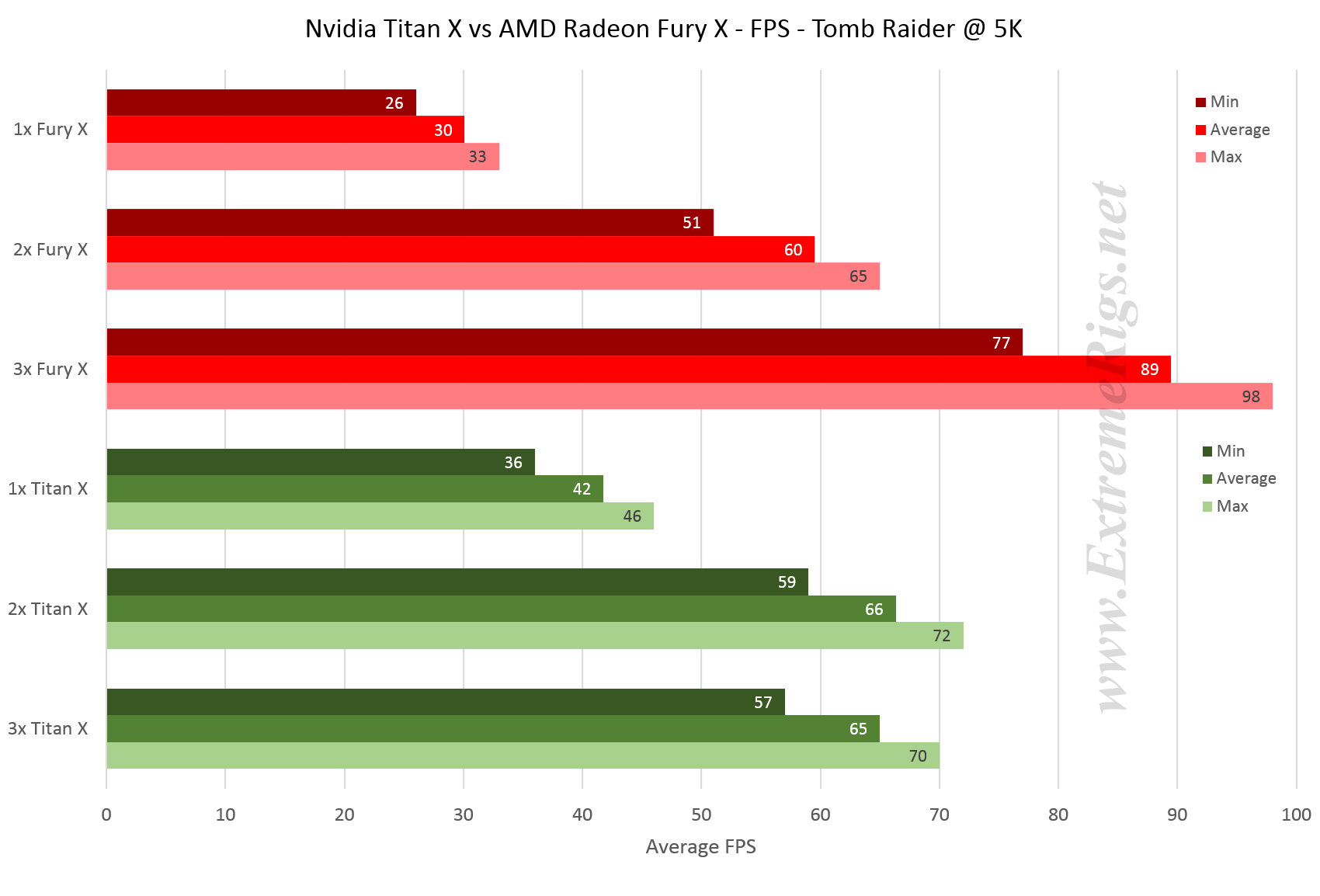 Tomb Raider is a game that AMD worked extensively with when working on their Tress FX technology. It’s still a surprise then to not see the Fury X outperform the Titan X until the Titan X scaling kicks in. Of course the Titan X has an overclock so perhaps it’s simply too much to expect the Fury to beat out a Titan in the single GPU contest.
Tomb Raider is a game that AMD worked extensively with when working on their Tress FX technology. It’s still a surprise then to not see the Fury X outperform the Titan X until the Titan X scaling kicks in. Of course the Titan X has an overclock so perhaps it’s simply too much to expect the Fury to beat out a Titan in the single GPU contest.
Amazingly AMD’s scaling is near perfect here – showing just how good their technology is when everything is working right:
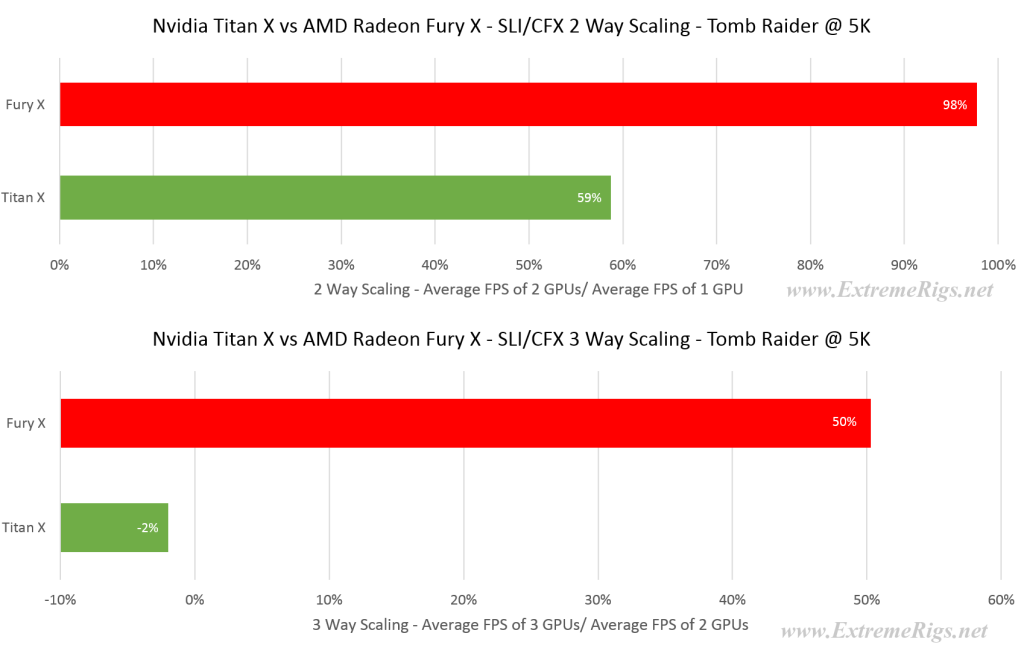
Nvidia on the other hand is giving up lots of possibly performance here. 3 Way SLI just seems to be broken and 2 way SLI gives only a modest increase in performance. Luckily it’s enough to provide playable FPS.
Let’s check the VRAM usage – again the first fury run failed to have vram logging turned on:
VRAM is surprisingly low here for such a recent game!
Usage charts:
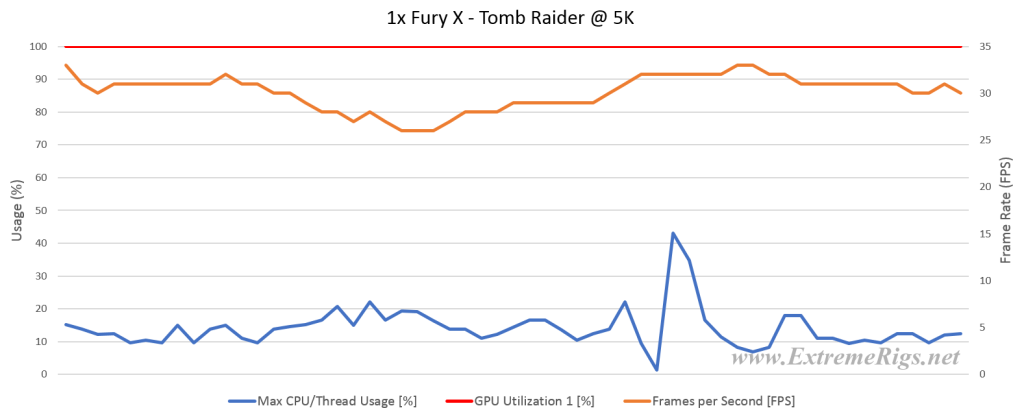
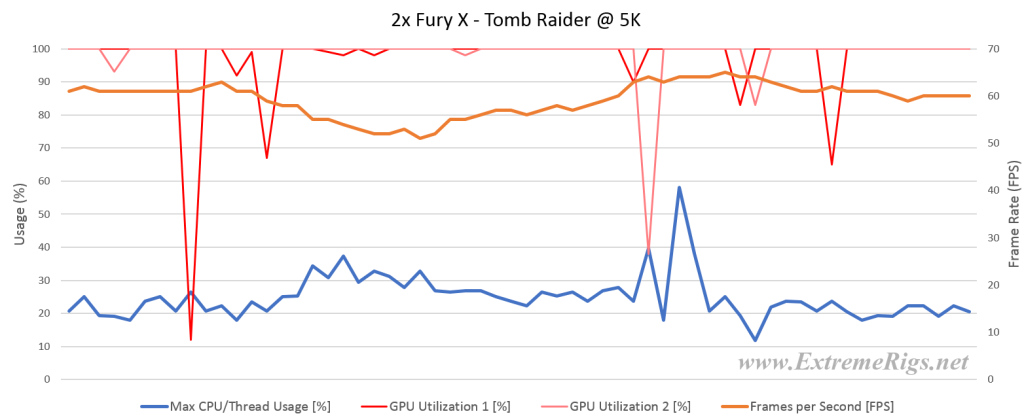
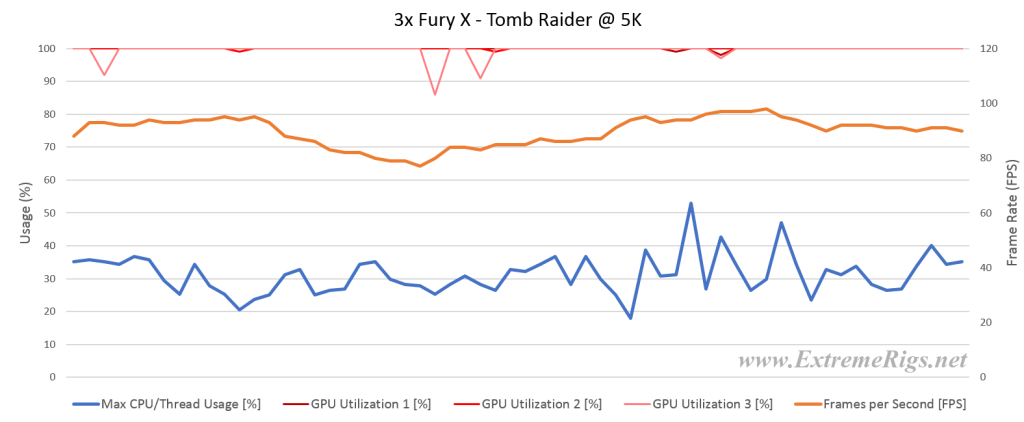 These are by far the cleanest usage charts from AMD. Clearly this game and drivers were optimized for AMD because there are none of the low utilization drop outs that we’ve come to expect from AMD.
These are by far the cleanest usage charts from AMD. Clearly this game and drivers were optimized for AMD because there are none of the low utilization drop outs that we’ve come to expect from AMD.
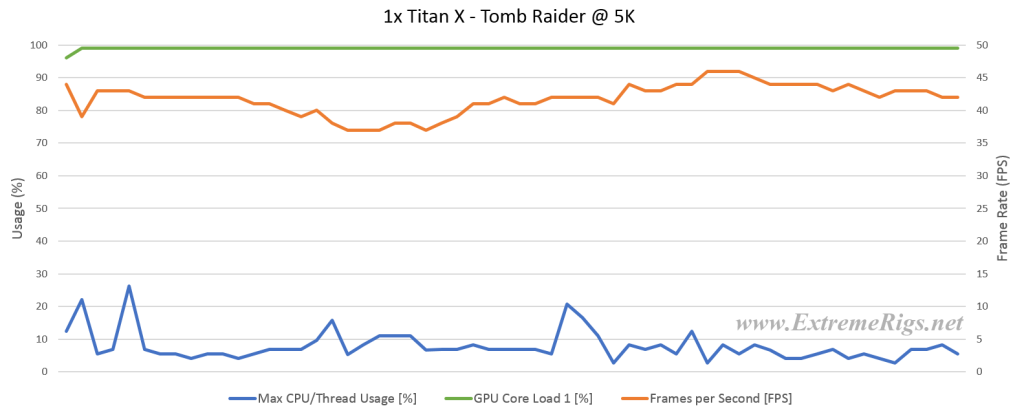
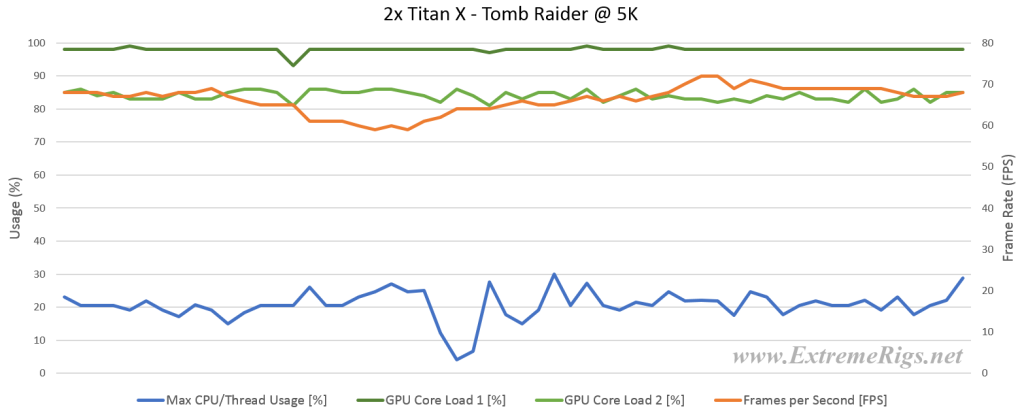
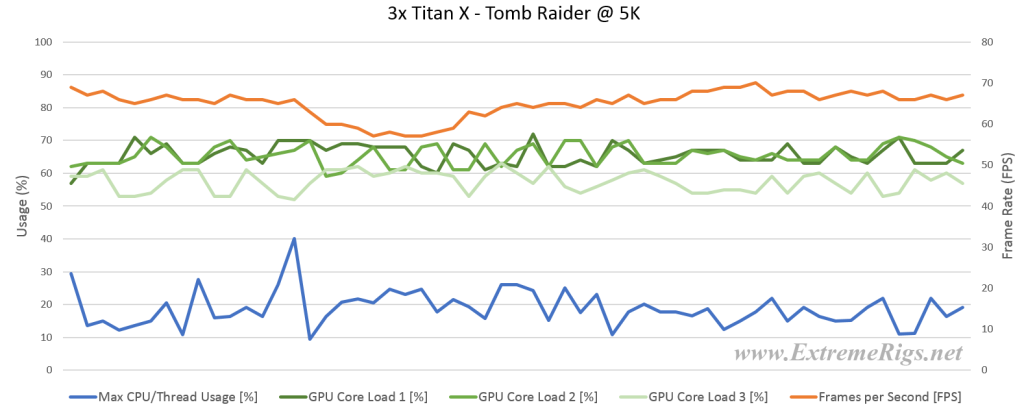 Nvidia on the other hand still has clean plots but you can clearly see that all GPUs are not being used as much as they should be. By the time 3 way scaling is being used all three GPUs are sitting at an average of 60% usage. FPS is only in the mid 60’s so nothing should really be limiting the GPUs here.
Nvidia on the other hand still has clean plots but you can clearly see that all GPUs are not being used as much as they should be. By the time 3 way scaling is being used all three GPUs are sitting at an average of 60% usage. FPS is only in the mid 60’s so nothing should really be limiting the GPUs here.
Tomb raider then is very playable with either AMD or Nvidia as long as you have 2 GPUs.








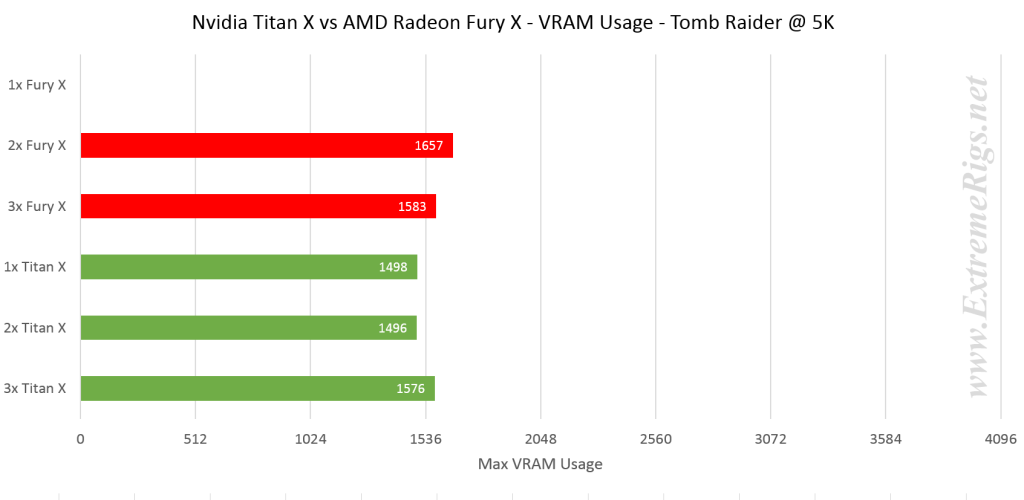





To be honest, I started reading this article with a thought that “well, how good can it be? ERs are watercooling guys so, nah! can’t expect too much”. But after reading the whole of it, I have to say, This is by far the one of the best comparative reviews I’ve ever seen, and really met all my expectations. Hats off to you guys!
Say, FuryX did have the claim in its pre-release rumor to be a TITAN X competitor, but then AMD shrunk that note to 980 Ti. So I think comparison with 980 Ti would’ve been better comparison (and seat clenching brawl) than this, and the clock-to-clock performance metrics but nonetheless, this is wayy too good also!
About capping the vRAM on FuryX in few games there, it also suffers from similar performance degradation on 4K and downwards. And as you may have seen on other reviews, FuryX does worse in sub-4K than the competition and even worse in 1080p. I’ve dug through every review out there yet haven’t found the reason behind this. What could be the reason?
And that scaling on nVidia – you know nvidia does claim that their SLI bridge isn’t a bottleneck, and so it is proved here :P. When AMD did introduce XDMA, I had this belief – AMD took the right path, bridges will suffer from less bandwith sooner or later, and PCIe already has the room for accommodating the data of the bridges. So XDMA did (well, now it is “do” :D) makes sense!
But it’s sad to see AMD not delivering smoother experience overall. If they could handle that thing, this should certainly deserved the choice over any of those higher average FPS of Titan X. But I think AMD is working on Win10 & DX12 optimized drivers and trying to mend it with bandages for now.
My only complain was the choice of TitanX over 980 Ti and clock-to-clock performance, but other than this, this is a very great review! Hats off to you again!
Agreed with Frozen Fractal. I was more than pleasantly surprised with the quality of this review, and I hope you continue to do these more in the future. A 980 Ti would have been nice to see too given the price.
Keep up the great work!
Thanks! I agree the 980 TI would have been a better comparison – then prices would have lined up. “Sadly” we only had Titan X’s and we weren’t willing to go out and buy another 3 GPUs to make that happen. However if anyone wants to send us some we’d gladly run em haha. I was simultaneously impressed with AMD’s results while saddened that after all the work on frame pacing that things still aren’t 100% yet. Hopefully
Question…you overclocked the Titan X to 1495MHz which is “ok” for a water cooling build. I won’t complain…though I’m surprised at why that’s all you were able to achieve as I can pull that off on Air right now (blocks won’t arrive until next week). Main question though…why wasn’t the memory overclocked? A watercooled Titan X has room to OC the memory by 20%, bumping up the bandwidth to 400Gbps, which brings it quite a bit closer to the 512Gbps of the HBM1 in the Fury X.
Although we didn’t mention it the memory was running a mild OC at 7.4Gbps up from the stock 7gbps
6gbps – so yes about the same as your 20% 🙂This is what concerns me about your understanding of overclocking. The Titan X memory is 7GHz at stock. At 7.4GHz you’re only running a 5.7% OC on the memory…
Hah you’re right, I was looking at titan stock memory settings not titan x. Yes it could have been pushed harder. Still though single Titan X was really good compared to Fury X – the issue it had was scaling. So unless scaling is significantly effected by memory bandwidth then I don’t think it changes the overall results much. When we re-run with overclocked furies we’ll spend a bit more time on the Titan X overclock too.
Don’t get me wrong…SLI scaling is definitely an issue and will still exist regardless. But you’d be surprised how important memory clocks can be depending on the test you’re running. I found this out when I was running the original GTX Titan Tri-Sli in the overclock.net unigine valley bench competition and came in second place. Leave the official redo for your next review of Fury X OC vs Titan X OC, as you mentioned. But to satisfy your own curiousity, try a higher memory clock and see what happens. If you were looking to squeeze out every last ounce out of your Titan X, you should check out http://overclocking.guide/nvidia-gtx-titan-x-volt-mod-pencil-vmod/ as well.
My Phobya nanogrease should be coming in tomorrow so I’ll finally be putting my blocks on as well. I’m going to compare my performance results with yours next time you run your benches. So make sure you do a good job. 😉
Excellent review. I am also running an Asus Rampage Extreme V with a 5960x OC’d to 4.4Ghz so your data really was telling. I’m running a single EVGA GTX980TI SC under water. I previously ran 2 Sapphire Tri-X OC R9 290s under water but opted to go with the single card.
Did you use a modded TitanX bios? What OCing tool did you use to OC the TitanX. I would like to try to replicate the parameters and run the single 980TI to see how close I am to your single TitanX data. Thank you.
Eh, i don’t really see the point of running AA in 5K 😛 Too bad it’s 5K btw, 4K is more reasonable. Too bad Fury X has problems with the Nvidia titles(W3 for example).
But man, the scaling and texture compression on amd cards are absolutely amazing. If only they weren’t bottlenecked by the HBM1’s 4GB of VRAM.
[…] Review: Titan X vs Fury X in a Triple CFX SLI Showdown […]
[…] Review: Titan X vs Fury X in a Triple CFX SLI Showdown […]
[…] Review: Titan X vs Fury X in a Triple CFX SLI Showdown […]
Comments are closed.